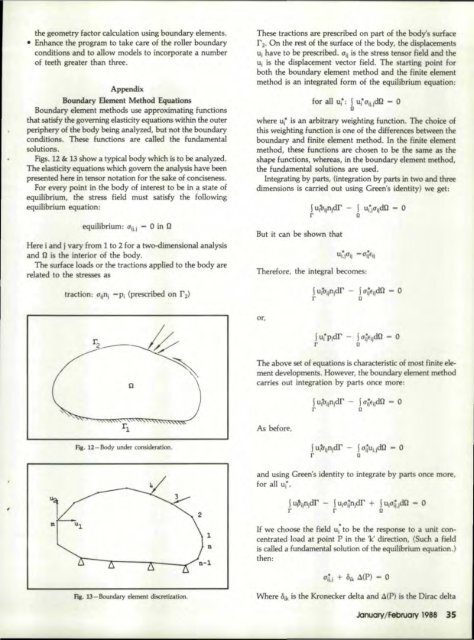Download PDF - Gear Technology magazine
Download PDF - Gear Technology magazine
Download PDF - Gear Technology magazine
Create successful ePaper yourself
Turn your PDF publications into a flip-book with our unique Google optimized e-Paper software.
the geom.etry factor calculationusing boundary elements ..<br />
• Enhance the program to take care of the roller boundary<br />
conditiens and to allow models to incorporate a number<br />
of t,eeth greater than three.<br />
Appendix<br />
Boundary Element Method Equations<br />
Boundary element methods use approximating functions.<br />
that satisfy the governing ,elasticity equations wi.tmn the outer<br />
periphery ,of the body being analyzed, but not the boundary<br />
,conditions. These functions are called the fundament.al<br />
solutions.<br />
figs. 12 &; 13 showa typicatl body which is to be analyzed.<br />
The ,elasticity equations which govern the anal:ysis have been<br />
presented here in tensor notation for the sake of conciseness.<br />
for every point in the body of interest to be ina state of<br />
equilibrium, the stress field must satisfy the following<br />
equilibrium equation:<br />
equilibrium: aij.1 - 0 in 'D<br />
Here iand j vary from 1 to 2 for a two-dimensional analysis<br />
and 0 is the interior of the body.<br />
The surface loads or the tractions applied to the body are<br />
related to the stresses as<br />
These tractions are prescribed on part of the body's surface<br />
I'2' On the rest of the surface of the body, the displacements<br />
U.i have to be prescribed. Uijis the stress tensor field and 'the<br />
u, is the displacement vector field. The starting point for<br />
both the boundary element method and the finite element<br />
method is an integrated form of the equilibrium 'eq-uation:<br />
for all ut': J Uj"'uiHdO - 0<br />
D '<br />
where uj is an a.rbitra:ry wei,ghtin-8 function. The choice of<br />
this weighting .function is one of the differ,ences between the<br />
boundary and ~fin]teelement method. In the finite element<br />
method, these functions are chosen to be the same as the<br />
shape functions,. whereas, in the bound~ry element method,<br />
the fundamental solutions are used.<br />
Integrating by parts. (in~egration by parts in. two and ,three<br />
dimensions is carried eut using Green's identity) we get:<br />
But it can be shown<br />
lI u~ I II ..n·dI' I - J uj*ju..dO - .-1]--- - 0<br />
r<br />
Q<br />
that<br />
Therefore, the integral becom s:<br />
J utlrijnj,dr<br />
r<br />
f u~fjidO - 0<br />
Q<br />
or,<br />
Iut pldr - J ,uljflj

















